Multinational Force and Observers
The Multinational Force and Observers (MFO) is an international peacekeeping force overseeing the terms of the peace treaty between Egypt and Israel. The MFO generally operates in and around the Sinai peninsula.
Background
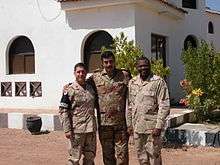
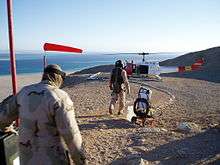

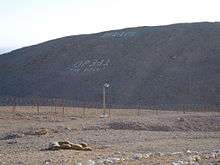
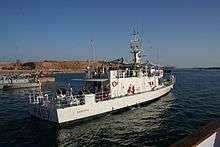
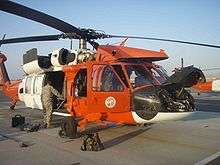
On September 17, 1978, the Camp David Accords were signed by Israeli Prime Minister Menachem Begin and Egyptian President Anwar Sadat under the sponsorship of United States President Jimmy Carter. The accords provided for a full Israeli withdrawal from Sinai.
Following the signing of the Egypt–Israel Peace Treaty on March 26, 1979, the United Nations was asked to provide the peacekeeping forces for the Sinai Peninsula mandated in the treaty. The terms of the treaty required the presence of international peacekeepers to ensure that both Israel and Egypt kept to the provisions regarding military build-up along the border.[1]
Initially, the peacekeeping force was provided by the U.S. Sinai Field Mission, while efforts were made to create a UN force.
On May 18, 1981, the President of the UN Security Council indicated that the UN would be unable to provide the force, due to the threat of a veto of the motion by the USSR at the request of Syria.
As a result of the UN Security Council impasse, Egypt, Israel and the United States opened negotiations to set up a peacekeeping organization outside the framework of the UN. On August 3, 1981, the Protocol to the Treaty of Peace was signed, establishing the Multinational Force and Observers.[1]
Mission
The mission of the MFO is:
"... to supervise the implementation of the security provisions of the Egyptian–Israeli Treaty of Peace and employ best efforts to prevent any violation of its terms."[2]
This is accomplished by carrying out four tasks:
- Operating checkpoints, observation posts and conducting reconnaissance patrols on the international border as well as within Zone C,
- Verification of the terms of the peace treaty not less than twice a month,
- Verification of the terms of the peace treaty within 48 hours, upon the request of either party,
- Ensuring freedom of international marine navigation in the Strait of Tiran and access to the Gulf of Aqaba
Over the three decades that the MFO has carried out its mission it has proven a highly successful force. The desire for peace on the part of both Egypt and Israel, combined with the effectiveness of the MFO, has resulted in a durable and lasting state of peace between these two nations.[3]
Organization
The MFO has its main headquarters in Rome, where it is headed by the Director-General. It also has two regional offices, in Tel Aviv and Cairo, while the Force itself is based in Zone C on the Sinai Peninsula, under the command of the Force Commander.
The Force Commander is responsible for the military elements of the MFO, which comprise:
- Headquarters
- Three infantry battalions (FIJIBATT, COLBATT and USBATT)
- 1st US Support Battalion (Formerly the Logistical Support Unit)
- Coastal Patrol Unit (CPU)
- Rotary Wing Aviation Unit (AVCO)
- Fixed Wing Aviation Unit (FWAU)
- Transport and Engineering Unit (TREU)
- Military Police Unit (FMPU)
- Flight Following (Air Traffic control) Unit
The Observer contingent of the MFO is made up entirely of US civilians. The observers are either seconded from the US State Department or retired US military personnel.
States involved
The personnel for these come from twelve states:
-
 Australia – From 1982 until 1985 the majority of the Australian contingent was made up of 100 personnel mainly from the RAAF to support 8 RAAF Iroquois helicopters. 25 Australian Army personnel based at Force HQ (departing in 1986 and returning in 1993 replaced in the interim by a contingent from the United Kingdom)[4] An Australian Army Officer, Major General David B. Ferguson, AM, also commanded the Force from 21 April 94 to 10 April 97.[5][6]
Australia – From 1982 until 1985 the majority of the Australian contingent was made up of 100 personnel mainly from the RAAF to support 8 RAAF Iroquois helicopters. 25 Australian Army personnel based at Force HQ (departing in 1986 and returning in 1993 replaced in the interim by a contingent from the United Kingdom)[4] An Australian Army Officer, Major General David B. Ferguson, AM, also commanded the Force from 21 April 94 to 10 April 97.[5][6] -
 Canada – 70 personnel within the Force and Contingent HQs in addition to the Operations, Liaison, V.I.P. Visit Office, Air Traffic Control, Transport, Support and Personnel Branches[7] and effective 23 March 2015, the Force Military Police Unit.[8]
Canada – 70 personnel within the Force and Contingent HQs in addition to the Operations, Liaison, V.I.P. Visit Office, Air Traffic Control, Transport, Support and Personnel Branches[7] and effective 23 March 2015, the Force Military Police Unit.[8] -
 Colombia – Infantry battalion (COLBATT) – 358 personnel (Batallón Colombia No. 3)
Colombia – Infantry battalion (COLBATT) – 358 personnel (Batallón Colombia No. 3) -
 Czech Republic – 3 personnel based at Force HQ (CZECHCON), 15 personnel with CASA C-295M transport aircraft
Czech Republic – 3 personnel based at Force HQ (CZECHCON), 15 personnel with CASA C-295M transport aircraft -
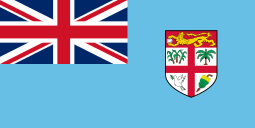 Fiji – Infantry battalion (FIJIBATT) – 329 personnel
Fiji – Infantry battalion (FIJIBATT) – 329 personnel -
 France – 2 personnel based at Liaison unit. (FRENCHCON)
France – 2 personnel based at Liaison unit. (FRENCHCON) -
 Hungary – Military Police Unit – 41 personnel (HUNCON)
Hungary – Military Police Unit – 41 personnel (HUNCON) -
 Italy – Coastal Patrol Unit with 75 personnel and 4 ships: P-405 Esploratore, P-406 Sentinella, P-407 Vedetta and P-408 Staffetta (ITCON)
Italy – Coastal Patrol Unit with 75 personnel and 4 ships: P-405 Esploratore, P-406 Sentinella, P-407 Vedetta and P-408 Staffetta (ITCON) -
 New Zealand – (NZCON)
New Zealand – (NZCON) -
 Norway – 6 personnel based at the Force HQ[9] including the Force Commander as of 12 October 2007 – Major General Kjell Narve Ludvigsen[10]
Norway – 6 personnel based at the Force HQ[9] including the Force Commander as of 12 October 2007 – Major General Kjell Narve Ludvigsen[10] -
 United States – The United States contributes three units collectively known as Task Force Sinai:[11]
United States – The United States contributes three units collectively known as Task Force Sinai:[11]
- Force HQ – 40 personnel
- Infantry Battalion (USBATT – typically drawn from Army National Guard units) – 440 personnel
- Support Battalion – 235 personnel including the following components:
- Headquarters
- Medical Company consisting of Dental, Medical, Physical Therapy, Veterinarian, Medical Logistics (Medical Supply & Medical Maintenance), and Preventative Medicine.
- Explosive Ordnance Disposal Detachment (EOD)
- Aviation Company
-
 Uruguay – 87 personnel with Transport and Engineering Unit
Uruguay – 87 personnel with Transport and Engineering Unit -
 United Kingdom - 1 personnel of Major rank; to be augmented with 100 troops in March 2016.[12][13]
United Kingdom - 1 personnel of Major rank; to be augmented with 100 troops in March 2016.[12][13]
Uniforms
Military
Military personnel serving with the MFO wear national military dress appropriate to the climatic conditions of the Sinai (except for some contingents like Uruguay, Australia and Fiji that keep the Jungle-type uniform). In the case of the U.S. Army, the Sinai saw the first use of the desert version of the Battle Dress Uniform, the six-color Desert Battle Dress Uniform which would later be worn during Operations Desert Shield and Desert Storm, then the three-color Desert Combat Uniform—currently the U.S. Army wears the standard Army Combat Uniform (ACUs). Canada, Colombia, France, Hungary, New Zealand and Norway have all developed or adopted their own desert uniform for use in the Sinai and elsewhere. All contingents wear national flags or crests to identify their country of origin.
MFO crests are sewn on uniforms to identify the wearer as a member of the force. All military members of the force wear a terracotta-colored beret or bush hat. Terracotta-colored helmet covers are provided for soldiers wearing field gear and/or body armor. Some contingents, such as that of Colombia, also wear terracotta neck scarves when on parade. During the 1980s a terracotta-colored "ranger" patrol hat was also in use, but was discontinued by the 1990s.
The terracotta beret is unique to the MFO and was selected to show that the force is not a United Nations peacekeeping force. UN peacekeeping forces wear a distinctive light blue beret. A metal or cloth MFO badge is worn on the beret.
Civilian observers
The 15 civilian observers employed by the MFO originally wore uniforms of highly visible orange (a relic of the Sinai Field Mission, whose personnel wore such uniforms) while carrying out their treaty verification duties. In 2002, a change was made to a bright orange shirt worn with khaki trousers. The orange shirts have since been replaced by black polo shirts.
Decorations
Peacekeepers who complete a tour of service in the Sinai of six months are authorized their first Multinational Force and Observers Medal. These are commonly presented at contingent medal parades. Each six-month tour after that authorizes the wearer to place a number on their ribbon (beginning with the number "2"). Civilians employees of the Force are authorized to wear the MFO Civilian Medal for the same terms of service as peacekeepers. Finally there is the Director General's Award, which is presented to both peacekeepers and civilians for outstanding service or action on behalf of the MFO.[14] Other awards for service or merit are in accordance with the practices and traditions of the individual contingents.
Chronology
- January 1982
Approximately 160 U.S. soldiers from Fort Bragg, North Carolina, were deployed to the Sinai. The mission of this augmented company size unit was to establish support facilities in preparation for the upcoming arrival of the infantry battalions to monitor the peace. This was not a typical U.S. Army logistical company. Initially those who deployed were required to wear civilian clothing, due to the security threat. They arrived in the middle of the night and were bussed to Etam Air Base in Israel, which would later be renamed El Gorah after the April 25, 1982 transfer of the Sinai Peninsula to Egypt. These soldiers were to prepare to assume the mission of the Sinai Field Mission. The goal was to establish a command structure, fixed and rotary aircraft support, parts support, water and petroleum supply, medical, logistics for the MFO, which would later assume the mission.
Upon arrival they were initially housed in several buildings which were in existence as part of Etam Airbase. It was several months before permanent buildings were in place.
- March 1982
Australian and New Zealand military aviation units assemble and are deployed into the region on March 20, 1982, as the Rotary Wing Aviation Unit.
- April 1982
The MFO assumed its mandate on April 25, 1982, the day Israel handed over sovereignty of the Sinai Peninsula to Egypt. In 1995 the United States experimented with a composite battalion consisting of National Guard soldiers from Virginia and Maryland, and Regular Army soldiers from the 82d Airborne Division and the 101st Airborne Division (Air Assault). In April 2006, the U.S. Third Army, in its role as Central Command's Coalition Forces Land Component Command (CFLCC) assumed command of the 1st Corps Support Command (1st COSCOM) from the XVIII Airborne Corps. Under U.S. Army reorganization, the 1st COSCOM has been re-designated as the 1st Sustainment Command (Theater). Since January 2002, the United States has been supplying National Guard Infantry battalions.
- April 1983
Colonel Sitiveni Rabuka was appointed as Commanding Officer of the Fijian MFO contingent. After serving a two-year posting in the Sinai Colonel Rabuka returned to Fiji in 1985 to plan and stage a bloodless military coup which toppled the elected Fijian government on 14 May 1987.[15]
- February 1984
MFO Director-General Leamon Hunt was assassinated in Rome, Italy, while sitting in his chauffeur-driven armored car, outside the gates of his private residence. The assassins poured automatic weapon fire into the reinforced rear window until they were able to penetrate the glass and strike the director-general in the head. Responsibility for the assassination was claimed by Lebanese Armed Revolutionary Faction the Red Brigade.[16]
- March 1985
Due to the imminent end of the four-year Australian MFO commitment in April 1986, the governments of Israel, Egypt, and the United States invited Canada to provide a contingent. Canada agreed to replace Australia in the MFO and to supply a helicopter squadron, staff officers and a flight-following section of air traffic controllers totalling 136 military personnel. The Canadian Contingent (CCMFO) was brought on strength of the Canadian Forces on September 26, 1985.[17]
- December 1985
On December 12, 1985, a chartered Arrow Air DC-8 with 248 returning members of the U.S. 101st Airborne Division and eight flight crew crashed into the cold, damp landscape at the end of runway 22 at Gander International Airport in Gander, Newfoundland, with no survivors. The 101st was rotating home from a tour of duty with the MFO. The accepted theory is that the crash was caused by ice accumulation on the leading surfaces of the wings, but debate and speculation still rages that the crash may have resulted from some type of incendiary device placed on the plane.
- April 1986
The Australian contingent, consisting of staff officers and a helicopter squadron who were members of the initial deployment, withdrew in the course of their government's reduction of its peacekeeping commitments. They were replaced by the CCMFO Canadian Rotary Wing Aviation Unit, equipped with nine CH135 Twin Hueys, staff officers and flight following. The CCMFO was operational at El Gorah on March 31, 1986. Canadian tactical helicopter units rotated to El Gorah for six-month tours of duty. The primary units providing military personnel were 408, 427 and 430 Tactical Helicopter Squadrons and 403 Squadron Helicopter Operational Training Squadron.[18]
- December 1989
A Canadian CH-135 helicopter on a maintenance test flight crashes one mile north of El Gorah. Both crew members are injured, one seriously.
- March 1990
After four years with the MFO, the Canadian helicopter squadron was withdrawn. This was due primarily to Canada accepting a new commitment to send a helicopter squadron to Central America with a UN peacekeeping force. This left 28 Canadian Staff and Air Traffic Controllers in the flight following role with the MFO, a commitment which continues to the present day. Due to the Canadians' departure, the United States split their rotary wing unit between South and North camps.
- January 1993
The Australians, who had been replaced by a British contingent, returned to the mission, and the British contingent withdrew.[19] Lieutenant Colonel Martin Hamilton-Smith was the first contingent commander of the returning Australians. He went on to become a South Australian politician after his military career.[20]
- August 1994
Australian MFO contingent members were involved in a hit-and-run accident that they failed to report. The incident[21][22][23][24][25][26] came to light when one of the vehicle passengers, army Staff Sergeant David Hartshorn, reported it after he had been returned to Australia. Prima facie evidence of the incident was established and included in a formal inquiry by the Australian government in 2004.[27] In an article by News Limited Network journalist Ian McPhedran on 30 August 2012, former Staff Sergeant David Hartshorn has received an apology from former Australian Army Chief Lieutenant General David Morrison and Inspector General of the Australian Defence Force Mr Geoff Earley for being ordered not to report the hit and run accident.[28]
- January 1995
The 4-505 PIR assume duties as USBATT. This battalion is composed of Reservists and National Guardsmen in addition to active duty soldiers. The U.S. Army used this group as a test to see if reservists could take over the mission in the future.
- September 1995
A Hungarian contingent arrived to serve as the Force Military Police Unit. The Hungarians replaced the Dutch contingent, and as well as military police include two members of the Force staff, a doctor and a liaison officer.
- January 2002
The 2nd Battalion, 153rd Infantry Regiment of the Arkansas National Guard become the first National Guard unit to deploy to Task Force Sinai as part of Operation Noble Eagle. They relieved the 2-87th Infantry of the 10th Mountain Division based at Fort Drum, NY.[29]
July 2002
The Oregon National Guard assumed duties at South Camp from the Arkansas National Guard.
January 2003
The 180th Infantry Regiment of the Oklahoma National Guard assumed duties as the U.S. Batt at South Camp (MFO 44) as the first unit assigned under Operation Enduring Freedom.
July 2003
The Iowa National Guard assumed duties at as the U.S. Batt at South Camp (MFO 45).
- August 2005
An MFO vehicle carrying two members of the Canadian contingent was badly damaged, the results of an improvised explosive device (IED) attack. The Canadians were only slightly injured.
- January 2006
The 1-124th Cavalry assumed duties as the USBATT contingent. The 1-124th CAV is part of the 36th Infantry Division of the Texas Army National Guard. Units that were pulled together to complete the manning for the mission include elements of the 1-112th Armor and 3-112th Armor.
- February 2006
The MS al-Salam Boccaccio 98, an Egyptian Ro/Ro passenger ferry operated by El Salam Maritime Transport, en route from Duba (Saudi Arabia) to Safaga (Egypt), sank on 3 February 2006 in the Red Sea with 1400 passengers on board. Italian Coastal Patrol Unit (CPU) naval assets (ITS Vedetta and ITS Sentinella), MFO aviation (French contingent Twin Otter and one U.S. contingent UH-60A), supporting USBATT medical and land-based logistical elements all participated in the search and rescue operation. Once the MFO became aware of the disaster, the CPU was put on stand-by to provide Egyptian search and rescue (SAR) services with any assistance possible. Subsequently, over the course of three days, 3-5 February 2006, CPU ships patrolled for more than 90 hours in severe weather conditions. Eight passengers were rescued by MFO vessels.
- May 2007
A French Air Force de Havilland Canada DHC-6 Twin Otter aircraft on duty with the MFO Fixed Wing Aviation Unit crashed in the middle of the peninsula, 80 kilometres (50 mi) south of the town of Nakhl. All passengers and crew were serving members of the MFO, eight French and one Canadian, and all were killed. The aircraft reported trouble with one engine and was attempting an emergency landing on a highway when it struck a truck. It crashed and exploded moments later. The driver of the truck escaped unharmed.[30]
The aircraft was operated by the French Air Force as their contribution to the MFO. It made regular flights between the two main MFO bases at El Gorah and Sharm el-Sheik, as well as conducting observation missions as part of the MFO's mandate.
- December 2008
The Czech Republic and the MFO announced that the Czechs have entered negotiations to contribute three staff officers to the Force as part of a new, permanent Czech Contingent. This proposed addition to the MFO is part of the Czech Republic's strategic plan to become more involved in foreign operations and is subject to parliamentary approval.
- November 2009
The Czech Contingent (CZECHCON) is the newest member of the MFO family of troop-contributing nations. The first soldiers arrived in the Sinai on 17 November 2009. Contingent members consist of three staff officers in the following key positions: Assistant Chief of Staff (Lieutenant Colonel), Deputy Force Protection Information Officer (Major) and Force Engineering Staff Officer (Major). All officers will serve a voluntary one-year tour of duty with the MFO.
- September 2012
Dozens of armed militants attacked North Camp on Friday 14 September 2012, breaking down a wall of the facility housing the MFO headquarters, setting fire to vehicles and facilities. MFO soldiers defended the base and there was an exchange of fire. Four MFO members were reportedly wounded.[31][32][33][34]
- October 2013
Parts of the MFO view cutbacks of the military aid from United States to Egypt as negative for the stability in Sinai, as the military government had hit militants hard.[35]
- March 2014
MFO held a swearing-in ceremony to welcome the new Force Commander of MFO, Major-General Denis Thompson of Canada, formerly the Commander of CANSOFCOM.[36]
Sinai peacekeeping zones
Article 2 of Annex I of the Peace Treaty called for the Sinai Peninsula to be divided into zones. Within these zones, Egypt and Israel were permitted varying degrees of military buildup:
- Zone A: Between the Suez Canal and Line A. Egypt is permitted a mechanized infantry division with a total of 22,000 troops in Zone A.
- Zone B: Between Line A and Line B. Egypt is permitted four border security battalions to support the civilian police in Zone B.
- Zone C: Between Line B and the Egypt–Israel border. Only the MFO and the Egyptian civilian police are permitted within Zone C.
- Zone D: Between the Egypt–Israel border and Line D. Israel is permitted four infantry battalions in Zone D.
Within Zone C there are two main installations:
- North Camp is at El Gorah, 37 km southeast of El Arish and is the location of the military Force HQ.
- South Camp is located between the towns of Sharm el Sheikh and Naama Bay.
In addition there are thirty smaller sites at various points within Zone C. One remote observation post (OP 3-11) is located offshore on Tiran Island, requiring resupply by air or sea.
Zone C
Zone C is subdivided into sectors, each controlled by a Sector Control Center. The sectors are numbered from north to south and assigned:
- Sectors 1 and 2 – FijiBatt
- Sectors 3 and 4 – ColBatt
- Sectors 5 and 7 – USBatt (The 3 original sectors were reorganized into 2 sectors)[37]
Badges
- The MFO cloth badge worn by all military personnel
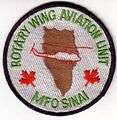 Badge worn by members of the Canadian Contingent Rotary Wing Aviation Unit 1989–90
Badge worn by members of the Canadian Contingent Rotary Wing Aviation Unit 1989–90- Souvenir patch for members of the 1st Support Battalion.
Life in the Sinai
Maintaining a good quality of life for MFO members in the Sinai is difficult, due to the remoteness and desolation of the region as well as more recent security concerns. Gym facilities, clubs, medical facilities, libraries and exchanges are provided at both North Camp and South Camp.[38] In addition, North Camp possesses a pool while South Camp boasts Herb's Beach, a section of the Red Sea coastline where it is possible to snorkel just a few feet into the water and see a variety of tropical fish.
The Force has its own magazine, the bimonthly and bilingual Sandpaper. Published in English and Spanish it is produced by the Press and Visits Office.[39] Sporting events are held at both camps. Members are encouraged to take trips to Israel and Egypt, usually in organized trips. In the Sinai there are also trips to Mount Sinai, Luxor, Cairo, Jerusalem, and other various sites within Egypt and Israel. A television and radio system also service North Camp and South Camp.[38]
There are venues for live shows at both camps and the U.S. organization Armed Forces Entertainment provides a variety of bands, dancers and other acts to keep the troops entertained.
At remote observation sites, which might house only a dozen peacekeepers, the quality of life is harder to maintain. During tours at remote sites peacekeepers have limited access to the internet, are provided with workout equipment, and are permitted mascots. Mascots are not allowed at the main camps, even though a veterinarian is available to maintain the health of the animals, which are almost always dogs.
After the original inception of the MFO, routine travel to al-Arish, Sharm el Sheikh and a beach facility near the Gaza Strip were restful getaways but recent security concerns over possible Hamas activity has changed that. Similarly, a bicycle competition known as the Tour de Sinai which had begun in 1985 had gone by the wayside in recent years.[40]
See also
- United Nations Emergency Force – the United Nations peacekeeping operation stationed in the Sinai after the Suez Crisis of 1956 to maintain the truce between Egypt and Israel
References
- 1 2 10 Tactical Air Group: Canadian Contingent Multinational Force and Observers Handbook (unclassified), page A-1. DND, Ottawa, 1986.
- ↑ Multinational Force and Observers Website accessed 30 August 2007
- ↑ Canadian Contingent Multinational Force and Observers Handbook, 10 Tactical Air Group, July 1987 (unclassified) pg D-1
- ↑ Australian Government Defence Website
- ↑ "Biography David Ferguson". Retrieved 22 January 2016.
- ↑ "Australians at War". Retrieved 22 January 2016.
- ↑ Op Calumet Canadian DND Webpage
- ↑ Canadian Forces Military Police depart for Op Calumet
- ↑ Norwegian Defence Force: Møtte nordmennene i Egypt (Norwegian)
- ↑ Multinational Force & Observers Website: Major General Kjell Narve Ludvigsen
- ↑ Multinational Force and Observers (2006). "Task Force HQ". Archived from the original on May 14, 2008. Retrieved 2008-12-10.
- ↑ "MFO - the Multinational Force & Observers". mfo.org. Retrieved 13 March 2016.
- ↑ "Defence Secretary announces UK support to peacekeeping mission". www.gov.uk. Retrieved 13 March 2016.
- ↑ Omsa Article http://webcache.googleusercontent.com/search?q=cache:J7F1RRt6WogJ:www.omsa.org/forums/showthread.php%3Ft%3D705+mfo+puccini&hl=en&ct=clnk&cd=2&gl=
- ↑ "Jewish Ideas Daily » Daily Features » How the Sinai Peacekeeping Force Staged a Military Coup in Fiji". Retrieved 22 January 2016.
- ↑ Associated Press (February 16, 1984). "Red Brigade claims assassination of Hunt". Kentucky New Era. p. 5A. Retrieved May 1, 2013.
- ↑ Canadian Contingent Multinational Force and Observers Handbook, 10 Tactical Air Group, July 1987 (unclassified) pg 1
- ↑ Canadian Contingent Multinational Force and Observers Handbook, 10 Tactical Air Group, July 1987 (unclassified) pg 1 and A-4
- ↑ Australian Commonwealth of Australia Gazette S27 establishing Operation Mazurka Australia's contribution to MFO Sinai
- ↑ "Profile: Hon Martin Hamilton-Smith". Retrieved 22 January 2016.
- ↑ "Submissions received by the committee as at 21/02/05". Retrieved 22 January 2016.
- ↑ Former sergeant fighting a culture of cover-ups
- ↑ "Cover up forced soldier to quit". Chronicle. Retrieved 22 January 2016.
- ↑ "Haunting silence over fatal hit-and-run". The Australian. Retrieved 22 January 2016.
- ↑ "Whistleblower waits for apology". Chronicle. Retrieved 22 January 2016.
- ↑ "Cairo hit-and-run inspires dedicated paramedic". Chronicle. Retrieved 22 January 2016.
- ↑ "ParlInfo - FOREIGN AFFAIRS, DEFENCE AND TRADE REFERENCES COMMITTEE : 22/04/2004 : Effectiveness of Australia's military justice system". Retrieved 22 January 2016.
- ↑ McPhedran, Ian. "Army sorry over the cover-up of a hit-and-run in which the victim was 'only an Arab'". News.com.au. News Limited. Archived from the original on 6 February 2016. Retrieved 22 January 2016.
- ↑ "2-153rd Infantry Battalion "Gunslinger"". Global Security.Org. Retrieved January 12, 2010.
- ↑ "Quebecer among peacekeepers killed in Sinai plane crash". CBC News. Canadian Broadcasting Corporation. May 2007. Archived from the original on 23 June 2008. Retrieved July 28, 2008.
- ↑ Attack on Sinai base of Aust peacekeepers
- ↑ "Gunmen attack Sinai HQ of MFO peacekeeping force, four injured". The Times of Israel. Retrieved 22 January 2016.
- ↑ "Chaos in the Sinai: Will International Peacekeepers Be the Next Casualty?". Weekly Standard. Retrieved 22 January 2016.
- ↑ "Aust to provide $1.5m for Sinai mission". The Sydney Morning Herald. Retrieved 22 January 2016.
- ↑ BARBARA OPALL-ROME. "In Israel, Surprise, Anger Over US Aid Cuts to Egypt" DefenseNews, October 14, 2013. Accessed: 20 October 2013.
- ↑ "Canadian Denis Thompson leads Sinai peacekeeping force". CBC News. 4 March 2014. Retrieved 4 March 2014.
- ↑ Canadian Contingent Multinational Force and Observers Handbook, 10 Tactical Air Group, July 1987 (unclassified) A-4 and A-5
- 1 2 Servants of Peace, Office of Personnel and Publications, Multinational Force and Observers, June 1999, Rome. Page 25
- ↑ Sandpaper, Apollo Publishing, Cairo, Sept/Oct/Nov 2007. Page 3
- ↑ Sandpaper, Apollo Publishing, Cairo, Special Edition, June 2007. Page 20
External links
| Wikimedia Commons has media related to Multinational Force and Observers. |
- MFO official site
- Australians at War Government article - Yasser Arafat's 1994 return to the Gaza Strip via Sinai after his 1960s expulsion from the region
- Australian MFO Contingent site
- Dutch MFO page